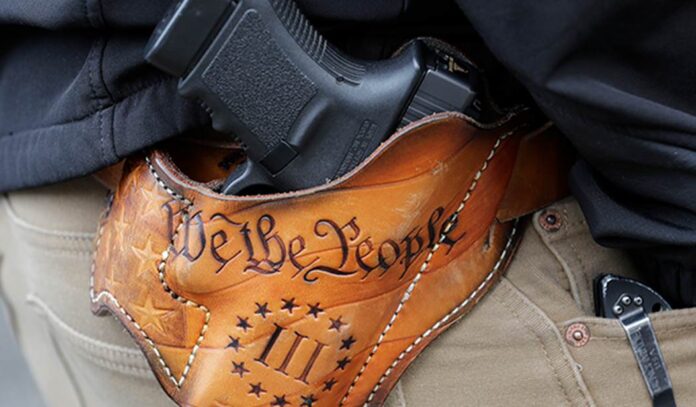The Ohio Supreme Court ruled on Thursday that firing a warning shot in lieu of shooting a person can be considered by courts as an act of self-defense. In today’s America, that’s a big deal.
In a split decision, the court ruled in favor of Tyler Wilson, who had been convicted by a lower court on charges of felonious assault with a firearm but not guilty of attempted murder. Four of the justices reversed the lower court rulings that found a claim of self-defense isn’t viable from a person who didn’t shoot to wound or kill.
The court held that Wilson’s shooting with a stated intent to “back [an aggressor] off” is protected by Ohio’s self-defense laws.
While the decision was a victory for gun rights, which is sure to incense the gun-grabbing left, Second Amendment supporters were surprised to learn that the decision was made by three liberal justices and one conservative justice.
Here’s more:
During an altercation at a gas station in 2021, Tyler Wilson fired a warning shot at Billy Reffett’s car, claiming he was acting in self-defense. Wilson claims Reffertt threatened him and pulled a gun on him.
But a Clark County judge said Wilson wasn’t protecting himself because he didn’t aim the gun at the supposed assailant, so the judge didn’t allow him to argue self-defense in court, seemingly saying that if Wilson was really scared for his life, he should have shot Reffertt.
Wilson was acquitted of attempted murder but was found guilty of felonious assault. He and sentenced to more than a decade in prison.
The Buckeye Firearms Association’s Rob Sexton believed the initial ruling against Wilson was unconstitutional.
If you’re in fear for your life or trying to protect yourself or other loved ones from harm, then a warning shot can be an element of self-defense.
In a 4-3 decision, the court agreed. Sexton was not only surprised by how the vote broke down; he also said the vote of the liberal justices made a stronger case for future self-defense claims.
Knowing that the High Court has agreed with that, even those that you would typically assume would not be necessarily pro-Second Amendment, makes a stronger case for future self-defense claims.
Liberal Justices Melody Stewart, Michael P. Donnelly, and Jennifer Brunner wrote the opinion, with conservative Justice Pat Fischer in concurrence of the judgment only — meaning he agreed but didn’t write an opinion on why.
Case Western Reserve University law professor Jonathan Entin suggested that the ruling was less about gun rights and more a question of how easy it should—or shouldn’t— be to assert self-defense. Entin stressed that the court didn’t say Wilson had acted in self-defense, only that the jury should have been allowed to consider whether he did.
In a dissenting opinion, Justice Joseph T. Deters wrote that Wilson’s version of what had happened didn’t constitute self-defense.
Wilson was charged with felonious assault … which makes it a crime for a person to knowingly ’cause or attempt to cause physical harm to another’ by means of a deadly weapon. There was no evidence that Wilson caused physical harm to Reffett, so the state of Ohio had to prove that Wilson attempted to cause physical harm to Reffett—a premise Wilson flatly denied.
Entin agreed with Deters:
That may expand the possibilities for self-defense because if it requires only a showing that you were trying to scare off an assailant, that might make self-defense something that more people try to assert.
That said, Entin admitted that requiring lethal violence isn’t ideal.
Realistically, if you got somebody who’s trying to scare off a possible assault, then maybe you don’t want to have a rule that says you’ve got to be trying to kill or, maim, this person before you can assert self-defense.
Either way, in my view, the decision was a positive step for self-defense — in an America that gets crazier and less predictable by the day.




